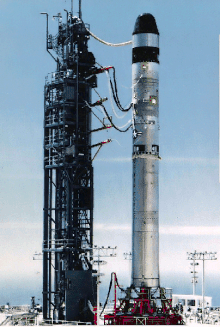 The first Titan 23G prior to launch | |
| Function | Expendable launch system |
|---|---|
| Manufacturer | Martin Marietta / Lockheed Martin |
| Country of origin | United States |
| Size | |
| Height | 31.4 m (103 ft) |
| Diameter | 3.05 m (10.0 ft) |
| Mass | 117,020 kg (257,980 lb) |
| Stages | Two or Three |
| Capacity | |
| Payload to LEO | |
| Mass | 3,600 kg (7,900 lb) |
| Payload to Polar LEO | |
| Mass | 2,177 kg (4,799 lb) |
| Payload to HCO | |
| Mass | 227 kg (500 lb) |
| Associated rockets | |
| Family | Titan |
| Launch history | |
| Status | Retired |
| Launch sites | Vandenberg, SLC-4W |
| Total launches | 13 |
| Success(es) | 12 |
| Failure(s) | 1 |
| First flight | 5 September 1988 |
| Last flight | 18 October 2003 |
| Type of passengers/cargo | Clementine QuickSCAT |
| First stage | |
| Powered by | LR-87 (one engine with two combustion chambers) |
| Maximum thrust | 1,900 kN (430,000 lbf) |
| Specific impulse | 258 seconds |
| Burn time | 156 seconds |
| Propellant | N2O4 / Aerozine 50 |
| Second stage | |
| Powered by | 1 LR-91 |
| Maximum thrust | 445 kN (100,000 lbf) |
| Specific impulse | 316 seconds |
| Burn time | 180 seconds |
| Propellant | N2O4 / Aerozine 50 |
| Third stage (Optional) – Star-37XFP-ISS | |
| Powered by | 1 Solid |
| Maximum thrust | 38.03 kN (8,550 lbf) |
| Specific impulse | 290 seconds |
| Burn time | 67 seconds |
| Propellant | Solid |
| Third stage (Optional) – Star-37S | |
| Powered by | 1 Solid |
| Specific impulse | 287 seconds |
| Propellant | Solid |
The Titan 23G, Titan II(23)G, Titan 2(23)G or Titan II SLV was an American expendable launch system derived from the LGM-25C Titan II intercontinental ballistic missile. Retired Titan II missiles were converted by Martin Marietta, into which the Glenn L. Martin Company, which built the original Titan II, had merged. It was used to carry payloads for the United States Air Force (USAF), NASA and National Oceanic and Atmospheric Administration (NOAA). Thirteen were launched from Space Launch Complex 4W (SLC-4W) at the Vandenberg Air Force Base between 1988 and 2003.[1]
Titan 23G rockets consisted of two stages burning liquid propellant. The first stage was powered by one Aerojet LR87 engine with two combustion chambers and nozzles, and the second stage was propelled by an LR91. On some flights, the spacecraft included a kick motor, usually the Star-37XFP-ISS; however, the Star-37S was also used.[1]
A contract to refurbish fourteen Titan II missiles to the Titan 23G configuration was awarded to Martin Marietta in January 1986. The first launch occurred on 5 September 1988, carrying a classified payload for the U.S. National Reconnaissance Office. Thirteen were launched, with the fourteenth going to the Evergreen Aviation Museum.[2] The final flight occurred on 17 October 2003, carrying a Defense Meteorological Satellite Program (DMSP) satellite.[3]
During refurbishment, the forward structure of the second stage was modified with the addition of a payload attachment fitting to attach the payload to the rocket, and installing a payload fairing to protect it during launch. The engines were refurbished, and the rockets' guidance and control systems were upgraded by Delco Electronics.
The former Titan IIIB pad at Vandenberg, SLC-4W, was modified to accommodate the Titan 23G, and was used for all thirteen launches.
- ^ a b Krebs, Gunter. "Titan-2". Gunter's Space Page. Retrieved 2009-04-29.
- ^ Kyle, Ed (2009-04-14). "Titan 23G Data Sheet". Space Launch Report. Archived from the original on 2022-03-21. Retrieved 2023-05-15.
- ^ Wade, Mark. "Titan". Encyclopedia Astronautica. Archived from the original on August 5, 2008. Retrieved 2009-04-29.